Almost twenty years ago, I saw my first electric blue Indigo Bunting at Point Pelee in southern Ontario. It was a rainy day but it still gleamed in a random ray of sunshine so vividly it looked artificial. Recently, I read at OutdoorOntario that Indigo Buntings often nest at Riverwood Conservancy, a park along the Credit River is Mississauga, not far from Toronto, Ontario. So I decided to try to find one and get a second look at these brilliantly blue birds.
Hunting for a Sparrow in the Tree Tops
My first ramble around Riverwood in early June showed me many wonderful sights, from a White Tailed Deer doe to Common Whitetail Dragonflies, but no Buntings. Sheepishly I realized I didn’t even know where to look for the birds. I’m used to birds finding me and then me looking up what type they were. I don’t normally go out looking for a specific species. So I went home and read up on Indigo Buntings.
These birds are small. According to The Sibley Guide to Birds, they are smaller than a House Sparrow and just slightly larger than a Goldfinch.
Male Common Whitetail Dragonfly
Female Common Whitetail Dragonfly
Hunting by Ear for Indigos
AllAboutBirds, by Cornell University, suggested that male Indigo Buntings, the bluest ones, typically sing heartily from the tops of trees, on power lines, and other high exposed spots. I listened to the call repeatedly. I even taped a version from a YouTube by Luc Fazio taken previously at Riverwood. To tape it, I made a short videotape of his video using my point and shoot camera.
Blue jays, by the way, do not sing at all. They make harsh frequent cries, often while flying. Eastern Bluebirds sing but their song is shorter, harsher and they don’t sing for as prolongued stretches, at least not according to what I’ve read. So if you have a brilliant blue bird warbling steadily from a high perch, the first one you should look up in your guide is an Indigo Bunting. Eastern Bluebirds also have a red front similar to a robin.
The next time I visited Riverwood I listened intently. I played the video on my camera to remind myself exactly what I wanted to hear. What did I hear?
Nothing.
I could hear Northern Cardinals, American Goldfinches, Yellow Warblers, American Robins, Starlings, Grackles, Cedar Waxwings, Chickadees, Catbirds, even a Gnatcatcher, but no Bunting.
Slow Patient Plodding Nets a Win
Still, I walked carefully around the maintenance road loop. And there it was! A male Bunting flew across the road in front of me, landed deep inside a shrub, turned around, then flew across the road again. It disappeared among the shrubs and raspberry canes in an unknown direction. The simple sight made my whole day brighten. Although I didn’t see it again that visit, it strengthened my resolve to try again.
The Perils of Bird Watching Out of Bounds
The third attempt I was nearly mowed down by a golf cart full of mulch. Luckily I was prudently standing to the side of the maintenance road so the cart bumpled by without mishap. I didn’t see or hear a single bunting but I did see a baby Eastern Cottontail rabbit and a spring-bright yellow striped Garter Snake.
The fourth attempt included dodging two golf carts, a Bobcat mini front-end-loader and a ride-on lawnmower.
It also involved my first long-term look at an Indigo Bunting.
Of course my second look was far away and in a force 8 gale! Better photos ahead taken during my long look three.
Stay Tuned for another Bit of Better Bunting Banter
Related Reading
Join In
Have you seen a burst of electric blue dart across your yard? Are Indigo Buntings a staple of your back yard bird watching or a piquante accent? Please share your experiences with a comment.

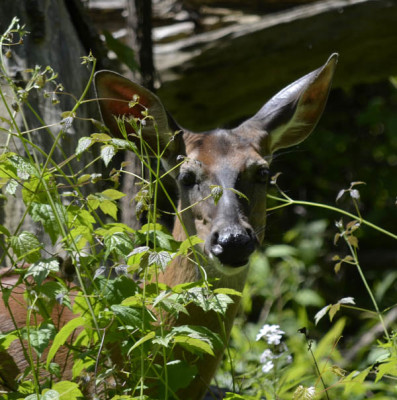
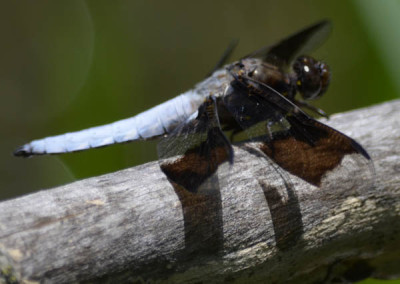
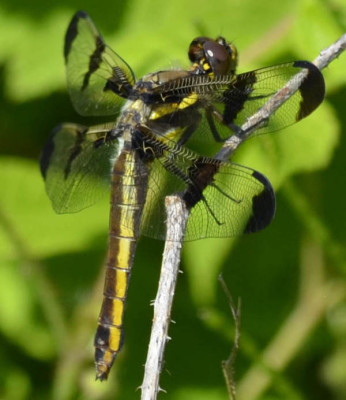
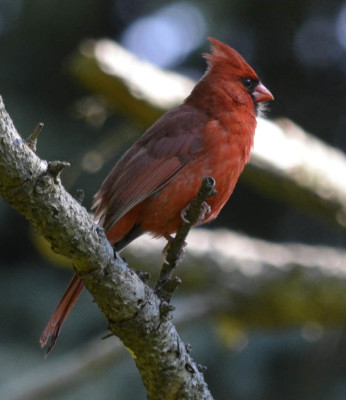
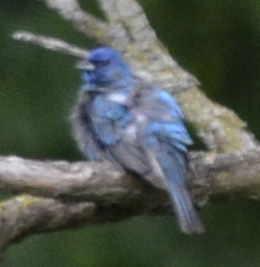
I have had an indigo bunting at my bird feeder for the past several days, usually between 6 and 7 in the evening. I’m not sure if the female has been. She’s harder to identify. I am sure that I’ve been hearing it for a week or so.
What a lovely visitor to your feeder! Here in Ontario, Indigo Buntings are uncommon enough that we’re really surprised the first time we see one, although in the USA they are fairly common field and feeder birds. I believe some of the birds have finished raising their young and are now starting to move around a bit, too. Thanks for sharing your sighting!